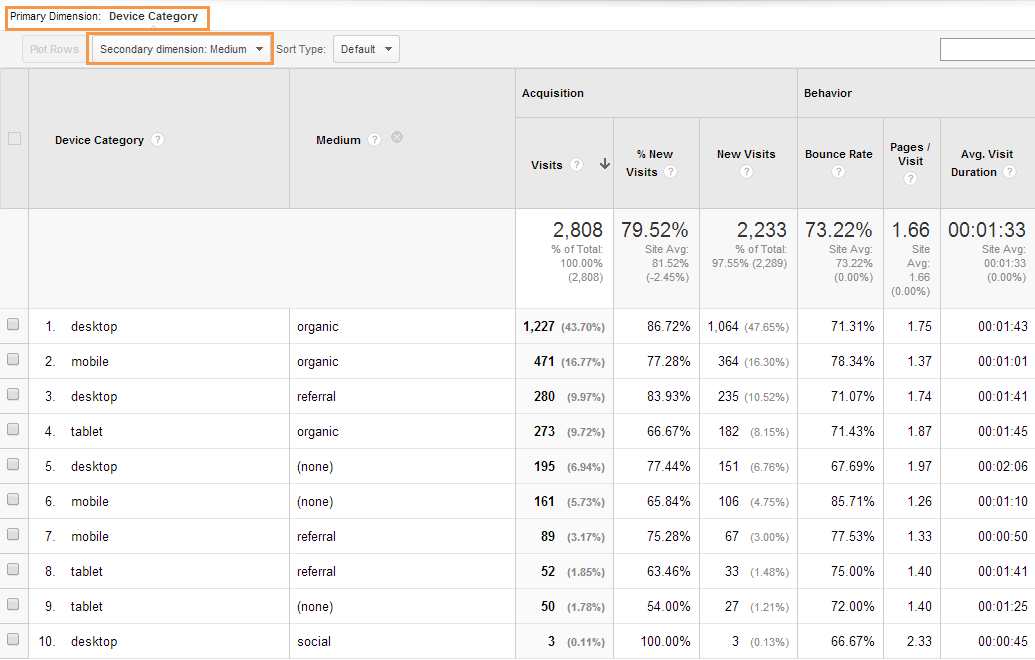Exactly How to Use Secondary Dimension in Google Analytics for Deeper Insights
Exactly How to Use Secondary Dimension in Google Analytics for Deeper Insights
Blog Article
Unlock Deeper Insights With Secondary Dimension in Google Analytics
With the huge expanse of data available in Google Analytics, the use of second measurements can considerably improve your logical capabilities. These additional layers of data use a nuanced perspective that can light up complex details within your key metrics. By strategically including secondary dimensions right into your evaluation, you can discover beneficial insights that may or else remain undiscovered. The capacity to analyze and divide customer behavior with greater precision opens a realm of opportunities for enhancing and maximizing approaches performance.
Understanding Primary Vs. Second Dimensions
When assessing information in Google Analytics, it is important to compare primary and additional measurements to acquire much deeper insights right into individual behavior. Primary dimensions are the primary groups whereby you can view your information, such as source/medium, tool, or touchdown page. These dimensions supply the basic structure for arranging and comprehending your data. On the various other hand, additional dimensions enable you to more study your key measurement data. By adding a second dimension, you can layer on additional details to your main measurement, making it possible for an extra granular evaluation. As an example, if your main dimension is the source/medium whereby users arrived on your website, including an additional dimension like geographic area can reveal where those individuals are located geographically. This added layer of details can aid you recognize fads, patterns, or anomalies that may not have actually appeared when taking a look at the main measurement alone. As a result, leveraging both secondary and key measurements in Google Analytics is essential for extensive data analysis and informed decision-making.
Making Use Of Second Measurements Properly
By incorporating secondary dimensions alongside main measurements, marketing professionals and experts can dig deeper right into the specifics of customer communications on their sites. Second dimensions allow users to sector and filter primary dimension information further, providing a more detailed view of customer habits, demographics, and interactions.
Additionally, additional dimensions allow users to contrast and contrast various data points within a single report, helping with a more comprehensive analysis of customer actions patterns. By leveraging secondary dimensions effectively, organizations can discover hidden understandings, optimize their advertising and marketing approaches, and improve the overall individual experience on their web sites.
Checking Out Typical Secondary Dimension Mixes
To better evaluate individual actions and fads in Google Analytics, it is beneficial to explore common combinations of second measurements. Some usual additional measurement mixes that provide valuable insights include evaluating web traffic sources with customer areas to comprehend where web site visitors are coming from geographically and how they discovered the site. Checking out user behavior metrics with additional measurements such as demographics or rate of interests can aid in targeting details target market sections a lot more efficiently.
Using Second Measurement in Custom News
Making use of secondary dimensions in custom-made reports permits for a more extensive analysis of information in Google Analytics, boosting the depth of understandings acquired. When developing personalized browse around these guys records in Google Analytics, integrating visit this web-site second measurements can give a more comprehensive view of how various measurements engage with each various other. This attribute makes it possible for individuals to delve much deeper into their information and reveal important connections that may not be quickly noticeable.
By applying second measurements in custom records, individuals can get a better understanding of their website or app web traffic. Combining the primary dimension of "source/medium" with the second measurement of "landing web page" can disclose which landing pages are executing best for web traffic coming from details sources. This understanding can aid marketing professionals maximize their campaigns and enhance overall conversion prices.

Enhancing Information Visualization With Second Measurement
When exploring information in Google Analytics custom-made records, including secondary measurements not only gives an extra detailed evaluation however additionally boosts the aesthetic depiction of understandings with data visualization. By adding a secondary measurement to your reports, you can enhance the way data exists, making it less complicated to identify patterns, trends, and relationships within your site's performance metrics.
Additional measurements can aid you sector your information even more, enabling a deeper understanding of user habits and interactions on your site. This improved level of granularity can be specifically helpful click for info when trying to isolate certain variables that may influence your internet site's efficiency - Secondary Dimension in Google Analytics.

Verdict
In final thought, leveraging second dimensions in Google Analytics permits a much more detailed evaluation of data, bring about deeper understandings and even more informed decision-making. Secondary Dimension in Google Analytics. By adding added layers of details to main data sets, online marketers and experts can uncover covert patterns, patterns, and relationships that offer a granular sight of user behavior and interactions. This boosted level of understanding enables optimization of campaigns and customized methods for particular audience sectors, ultimately boosting performance and conversion rates
On the various other hand, second dimensions allow you to further study your main dimension data. By adding a second dimension, you can layer on added info to your key measurement, making it possible for a more granular evaluation. If your main dimension is the source/medium with which customers arrived on your site, including an additional dimension like geographical area can reveal where those users are located geographically. By including second dimensions alongside main dimensions, analysts and marketing professionals can delve much deeper into the specifics of individual interactions on their internet sites. Additional dimensions allow customers to segment and filter key dimension data better, supplying a much more thorough view of user interactions, actions, and demographics.
Report this page